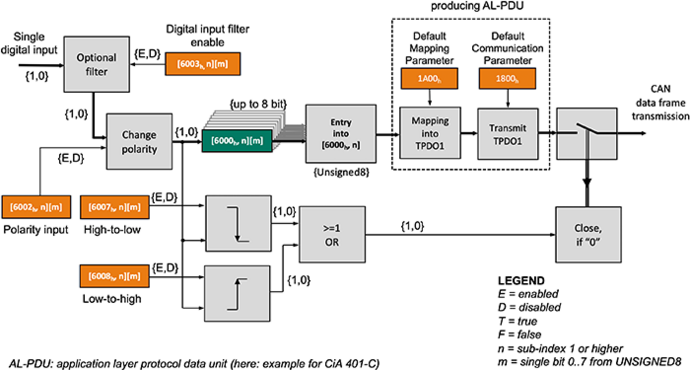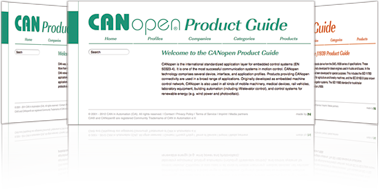CiA® 401 series: I/O device profile
This device profile series specifies the CANopen interface for modular devices with analog and digital inputs and outputs. The most recent edition provides three parts:
- CiA 401-B: Functional behavior and parameters
- CiA 401-C: Mapping to CANopen CC (classic)
- CiA 401-F: Mapping to CANopen FD

Part B contains block diagrams describing the relation between digital and analog process data and the related configuration parameters. Digital I/O lines are grouped to 8-bit (default), 16-bit, 32-bit, and 64-bit process data. The analog I/O process data feature resolutions of 8 bit, 16 bit (default), 32 bit, 64 bit, or REAL. Annex A specifies the parameters for joysticks. A single joystick can have 1-, 2-, or 3-axes movements. The joystick with three axes can support a rotational movement around one axis, additionally, to the movements along each of two axes as for example forward to backward and left to right movements. Foot pedals can be regarded as joysticks with a 1-axis movement.
Additionally, Part B specifies configuration parameters to adapt the input and output behavior (e.g. trigger conditions for inputs, output behavior in case of internal device failures) to the desired application. Most of these configuration parameters are optional. In order to cover a broad range of application requirements, it is recommended to implement as many of these parameters as possible.
Part C specifies the mapping to CANopen CC (CiA 301). The first TPDO (Transmit PDO) and the first RPDO (Receive PDO) support up to 8 by 8 digital (64) inputs respectively up to 8 by 8 (64) digital outputs. Besides byte-wise mapping, optionally bit-wise and word-wise mapping is possible. The remaining three default PDOs transmit or receive up to 12 analog inputs, respectively up to 12 analog outputs. The default resolution is 16 bit. Other resolutions are optional (e.g. 8 bit or 32 bit, or REAL).
Part F specifies the mapping to CANopen FD (CiA 1301). TPDO 1 indicates by default up to byte-wise grouped 512 digital input values. RPDO 1 provides by default up to 512 digital output values, also grouped byte-wise. TPDO 2 indicates by default up to 32 analog input values with a resolution of 16 bit. RPDO 2 provides by default up to 32 analog output values with a resolution of 16 bit.
In order to optimize the PDO communication, it is recommended to support PDO linking as well as variable PDO mapping. Alternatively, a manufacturer-specific set of default PDOs can be implemented. This is indicated in the “M” bit in the device type parameter.
CiA 401 version 3.1 is the legacy modular I/O device profile specification. Part 1 specifies generic I/O parameters and the mapping to CANopen CC. Part 2 is dedicated for joysticks.
The CiA 852 recommended practice for operator environment sub-systems (e.g. human machine interfaces in mobile machines) is based on the CiA 401 profile specification. Such sub-systems are for example simple remote-control units, operator seats with integrated joysticks, foot pedals, push buttons, indicators, etc., and complete operator cabins. They are dedicated but not limited to construction, mining, agriculture and forestry machines, to harbor cranes, boats and vessels, wheelchairs, and any other kind of machines on wheels.
CiA 852 recommends for example the numbering of sub-devices and the numbering of components of sub-devices. In total, the recommendation is suitable for up to 16 joysticks, up to 16 food-pedals, up to eight encoders, up to eight wheels, up to eight push-button clusters, up to eight indicator clusters, and up to eight displays. For all these functional elements, PDO (process data object) mappings are pre-defined.
| Title | Details | Status Size |
Published Action |
|---|---|---|---|
| CiA 401-B version 1.0.0.I/O device profile - Part B: Functional behavior and parameters | DescriptionThis document specifies the functional behavior and parameters of generic analog and digital input and output devices. Additionally, AnnexA specifies the functional behavior and parameters of specific analog and digital input and output devices such as joysticks.
Keywordsn/a | DSP3.1 MiB | 2023-06-19Login |
| CiA 401-C version 1.0.0I/O device profile - Part C: Mapping to classic CANopen | Descriptionn/a Keywordsn/a | DSP719 KiB | 2023-06-19Login |
| CiA 401-F version 1.0.0I/O device profile - Part F: Mapping to CANopen FD | Descriptionn/a Keywordsn/a | DSP586 KiB | 2023-06-19Login |
| CiA 401-1 version 3.1.0CANopen profile for I/O devices - Part 1: Generic I/O modules | DescriptionThis CANopen profile specifies generic CANopen digital and analog input and output devices. Devices compliant to this specifications use communication techniques, which are conform to
those described in the CANopen application layer and communication profile specification. In addition, programmable I/O devices may use communication techniques, which conform to those described in the CANopen additional application layer functions.
This device profile specification consists of several parts:
- Part 1: Generic I/O devices
- Part 2: Joysticks
This part of the device profile specifies the CANopen interface for modules with generic
analog and digital inputs and outputs. The first default TPDO and RPDO support up to 64 digital inputs, respectively up to 64 digital outputs both grouped byte-wise. The remaining default PDOs transmit or receive up to 12 analog inputs respectively up to 12 analog outputs both with a 16-bit resolution. All TPDOs are triggered by change-of-state. Therefore, default TPDOs containing analog inputs are disabled. Besides the default byte-wise access to digital I/Os, optional bit-, word-, and double-word
access may be supported. Besides the default 16-bit resolution for the analog I/Os, optional 8-bit, 32-bit, floating-point and manufacturer-specific resolutions may be supported. Several parameters are specified to configure the input and output behavior (e.g. trigger conditions for inputs, output behavior in case of internal device failures. Keywordsn/a | PAS1.9 MiB | 2013-02-12Login |
| CiA 401-2 version 3.1.0CANopen profile for I/O devices - Part 2: Joysticks | DescriptionThis CANopen profile specifies generic CANopen digital and analog input and output devices. Devices compliant to this specifications use communication techniques, which conform to those described in the CANopen application layer and communication profile specification. In addition, programmable I/O devices may use communication techniques, which conform to those described in the CANopen additional application layer functions.
This profile consists of several parts:
- Part 1: Generic I/O devices
- Part 2: Joysticks
This part of the profile specifies the CANopen interface for joysticks and similar devices, e.g. foot-pedals.
Keywordsn/a | PAS494 KiB | 2013-02-12Login |
| CiA 852 version 1.0.1CiA 401-based operator environment sub-system | DescriptionThis document recommends how to implement the CANopen interface for operator environments with human-machine interface functionality. It is based on the CiA 401 CANopen profile for generic I/O modules. It recommends how to use the digital and analog process data parameters specified in CiA 401. It also recommends a mapping of these parameters into PDOs. Keywordsn/a | TR650 KiB | 2021-04-03Login |
